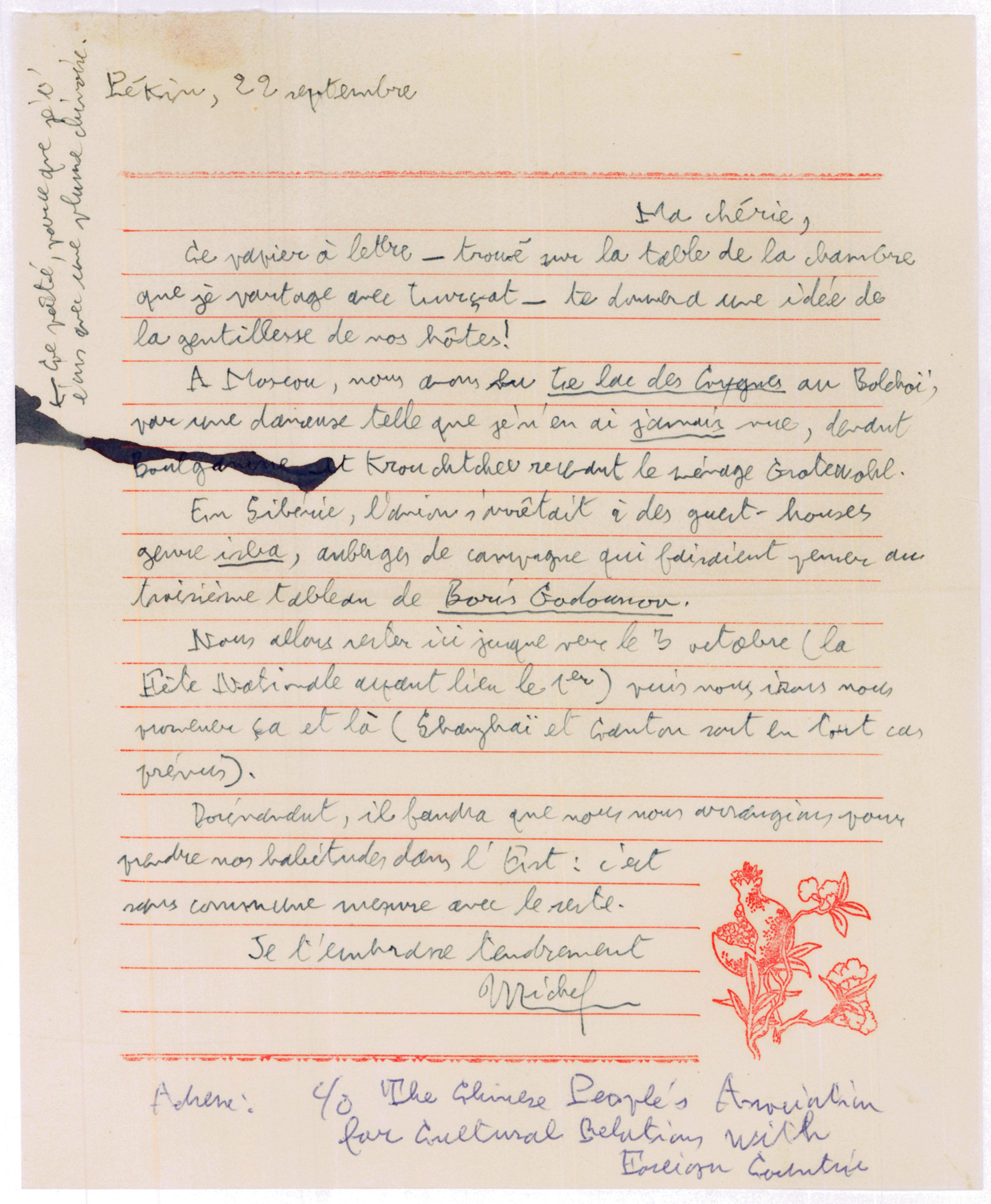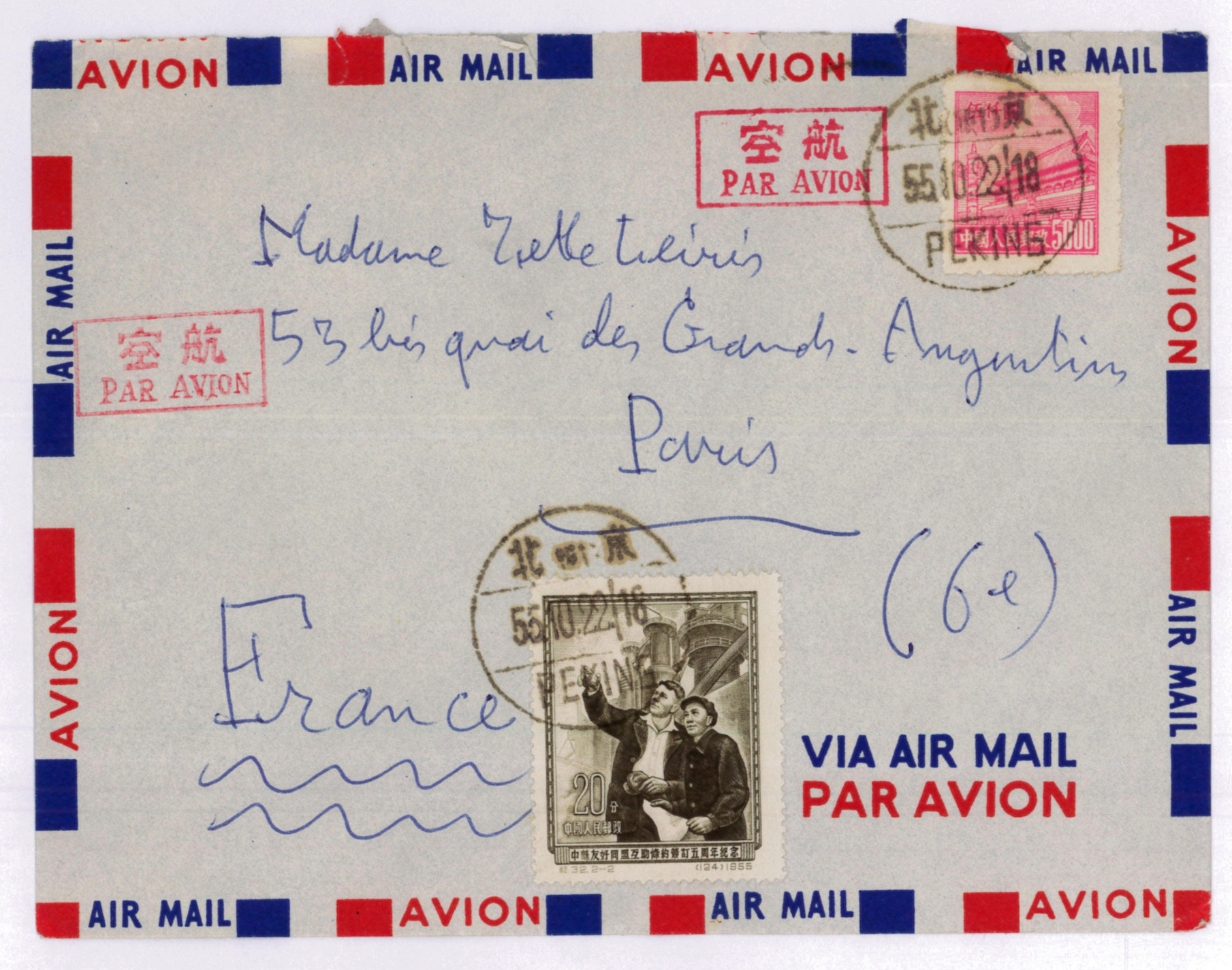Michel Leiris, Jean-Paul Satre, and Simone de Beauvoir on a trip to the New China of Mao Zedong
5 autograph letters signed ("Michel").
8vo and oblong 4to. Together 6 pp. With autograph envelopes.
€ 12,500.00
Highly interesting correspondence with his wife during a trip to China as member of a delegation of the Association des amitiés franco-chinoises which also included his friends Jean-Paul Sartre, Simone de Beauvoir (here addressed by her pseudonym "Castor"), and the painter Jean Lurçat.
In the first letter, dated 22 September, Leiris recounts their stay in Moscow and the journey to Beijing via Siberia, expressing his enthusiasm over a production of Swan Lake at the Bolshoi Theatre with Nikolai Bulganin, Nikita Khrushchev, and Otto Grotewohl, the prime minister of the GDR, in attendance. In closing, Leiris asserts that they will have to adapt to the Far East culturally: "Dorénavant, il faudra que nous nous arrangions pour prendre nos habitudes dans l'Est : c'est sans commune mesure avec le reste". A charming extra is an ink blot with the added explanation: "This stain is because I am writing you with a Chinese pen".
On 27 September, Leiris mentions a thirty-course dinner organized by the vice-minister for cultural relations and an upcoming visit to the Forbidden City. He now writes that interactions with Chinese people "are perfectly normal" despite "the exotic scenery", which he contrasts with his experiences in African and Caribbean countries: "Le plus étonnant en Chine c'est, décidément, qu'on y est absolument pas dépaysé, en dépit de tout l'exotisme du décor. Cela tient au fait qu'avec les gens les rapports sont parfaitement normaux et non pas ce qu'ils sont dans les pays africains ou antillais".
A letter that is erroneously dated "30 October" can be dated to 30 September, based on the content: Leiris gives his wife details concerning the programme of the coming weeks and his departure on 30 October that make no sense otherwise. Further, he describes preparations for large festivities on the following day, which certainly refers to the official celebrations of the Chinese National Day on 1 October 1955: "As tomorrow's party approaches, it is getting more and more magnificent: a huge crowd must have spent at least most of last night outside, watching the youth groups practicing their dances." A large "banquet for some 2,000 guests" the previous night, "presided over by Zhou Enlai", then First Premier of the People's Republic of China, was probably also connected to the festivities. A famous photo shows Simone de Beauvoir and Jean Paul Sartre on Tiananmen Square during the official celebration of the National Day.
On 5 October, Leiris writes from Changchung in Manchuria, a region that "feels a bit like the end of the world", and he is astonished "to see industrial buildings here".
Sartre and de Beauvoir were to depart for Shanghai the following day in order to organize accommodation for the rest of the delegation. The correspondence only resumes on 21 October 1955, after Leiris returns to Beijing from a trip to Shanghai and Hangzhou and before a further visit to Yunnan province. He reports on delegations from the "worker's club of the Beijing Opera Company no. 3", by whom they had been given an "overwhelming" welcome and "were even dressed up in Chinese actors' costumes and given large beards for photographs". Situations such as these make Leiris wonder how to convey his experiences without having people back in Europe think them mad: "Tout ce qu'on voit ici est suffoquant et la difficulté sera, au retour, de le faire saisir à ceux qui, ne l'ayant pas vu, nous regarderons comme des fous".
The correspondence forms a beautiful and thus far unpublished addition to the posthumous publication of Leiris's travel journals, the 1994 "Journal de Chine".
Three letters on lined stationery with a print of a pomegranate.













